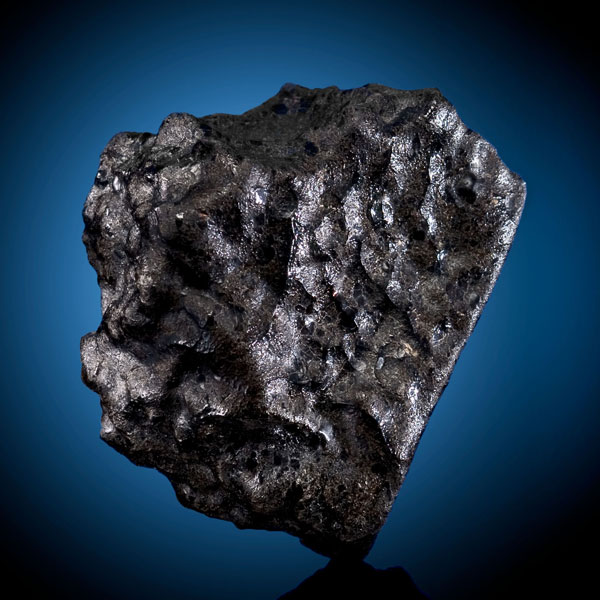Market for Martian Meteorites Heats Up

No mission to Mars has ever brought back rocks, but pieces of the Red Planet have turned up on Earth.
In late May, a Mars rock, small enough to fit easily into in an adult’s palm and covered in a glossy crust as black as space, sold for $43,750, a significant price, even for a piece of the fourth planet.
"It should be stated that Mars is among the rarest things on Earth," said Darryl Pitt, the dealer who sold this specimen at auction. [Latest Mars Photos]
This rock was a piece of the Tissint meteorite, which appeared as a fireball in the sky over the desert southwest of Tissint, Morocco, on July 18, 2011. Local people discovered the pieces of the Tissint meteorite in November, and a team of experts classified it, making the discovery official in January.
Tony Irving, a meteoriticist at the University of Washington, estimates the Tissint meteorite brought at least 33 pounds (15 kilograms) of Mars rock to Earth.
"It is going to be very hard to get an accurate tally because so many people have gotten involved," Irving said.
After its discovery, pieces of the Tissint entered a growing commercial market for meteorites. Demand, and prices, for meteorites increased dramatically as a result of publicity surrounding the first public auctions offering meteorites in the late 1990s, according to Pitt. The demand has, in turn, motivated meteorite hunters to find more of them.
Get the world’s most fascinating discoveries delivered straight to your inbox.
Now a year after it fell, Tissint pieces have been snapped up by collectors and institutions, but some of it is still up for sale.
Pitt estimates about 5 pounds (2.3 kilograms) are still on the market, including the largest chunk or "main mass" that weighs 2.8 pounds (1.3 kg), for which he is seeking a buyer. Pitt also plans to sell another, smaller fragment at a meteorites-only auction offered by Heritage Auctions in October.
A natural history favorite
This smaller fragment, a 1.6-ounce (46-gram) coal-colored rock, was among a selection of meteorites that Heritage Auction offered for sale on May 20. Its company included a small slice of giant iron meteorite discovered in 1902 in Willamette, Ore., that is on display at the American Museum of Natural History; slices of meteorites from the moon; and pieces of pallasite meteorites dotted with the gem peridot, the August birthstone.
At a media preview before the May 20 auction, the museum's director, David Herskowitz, showed off the meteorites.
"For everyone who has every worldly possession, he can actually own something from out of this world," Herskowitz said. "Meteorites are the most popular, the most highly collectible of all natural history [items]. There are more people that collect meteorites than there are that collect fossils, dinosaurs, even minerals." [Up For Auction: A Natural History Gallery]
Meteoritic miracles
A meteorite is a chunk of stone or metal from space that lands on the planet's surface. Most meteorites originate from the asteroid belt between Mars and Jupiter, when collisions fling out bits of asteroid, which eventually find their way into Earth's gravitational field
These must then survive the journey through Earth's atmosphere before striking the ground. If humanity is ever to recover them, the meteorites must land somewhere they can be found.
"I find almost every meteorite fall miraculous," said Geoffrey Notkin, a writer, meteorite dealer and host of the Science Channel's "Meteorite Men."
Meteorites ejected from the moon and Mars by asteroid collisions are rarer. About 65 Martian meteorites, including Tissint, have been recovered, Irving estimates.
A question of interest
Collectors are interested in more than just a meteorite's origin, Notkin said. For instance, beautiful specimens — think of sparkling specks of yellow peridot gems or the way iron meteorites resemble abstract sculptures — fetch higher prices, as do those with back stories, such a history that includes being traded out of a famous museum collection. Over time, meteorite prices have been increasing, partly due to inflation, partly due to increased interest, Notkin said.
The nearly $1,000 per gram cost of the Tissint specimen sold on May 20 is fairly typical for a high-quality Martian meteorite, he said.
The commercial meteorite market isn't limited to the meteorites themselves. Items struck by meteorites — a Chevy Malibu and a mailbox, for instance, have also sold for handsome prices.
A Martian origin
While missions to the moon have returned with lunar rocks, no Mars rocks have been brought back. So, why do scientists think meteorites like Tissint came from Mars?
In roughly 10 of the Martian meteorites, researchers have studied the composition of pockets of gas trapped in veins of melted rock formed by the shock of the ejection, and matched it to the composition of the Martian atmosphere. The remaining Martian meteorites have chemical features similar to those found to contain gas matching Mars' air.
Tissint appears to be one of a group of Martian meteorites, approximately 10 in all, that likely have been ejected from Mars 1.1 million years ago. All, however, have arrived on Earth at different times, the first landing 400,000 years ago.
Discoveries of meteorites, including those from Mars, are increasing; well over half of Martian meteorites have turned up since 2000.
Meteorites are most easily found in deserts, both icy and rocky ones. Expeditions to Antarctica have contributed to the increase in finds, as has the emergence of a meteorite-prospecting enterprise in northwestern Africa, including Morocco, where nomads and others search the desert for valuable rocks.
"It must be concluded that future discoveries elsewhere are limited mainly by insufficient effort. Let's get going!" Irving writes on his website.
Follow LiveScience writer Wynne Parry on Twitter @Wynne_ParryorLiveScience @livescience. We're also on Facebook & Google+.



